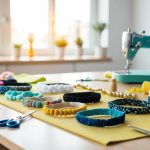The Best DIY Fashion Tips for Every Season: Timeless Style Year-Round
Seasonal Fashion DIYs
For fashion enthusiasts keen on creating their own looks year-round, seasonal DIY fashion projects offer an engaging and sustainable choice. From cozy winter wear to chic summer outfits, there are countless ways to refresh our wardrobe with hands-on creativity.
Winter Warmers: Cardigans and Leggings
During the colder months, warmth and comfort become our top priorities. A handmade cardigan can be both stylish and functional. Opt for thick, soft yarns that provide insulation. Adding decorative buttons or patches can elevate the look. Leggings are another winter staple. By selecting thicker, fleece-lined fabrics, we ensure that our DIY leggings keep us warm. Customizing them with side zippers or ankle embellishments can make a unique fashion statement.
Summer Statements: Dresses and Sandals
In the summer, lightweight and breezy materials are best. We can transform old fabrics into airy summer dresses. Using patterns that allow for flow and movement keeps us comfortable. Additionally, repurposing scarves or oversized shirts into dresses is both cost-effective and fashionable. Pom pom sandals add a playful touch to summer attire. By attaching colorful pom poms to simple sandal straps, we create eye-catching footwear that pairs well with our custom-made dresses.
Spring and Fall Transition Pieces
Spring and fall present unique fashion challenges due to fluctuating temperatures. Cardigans and light sweaters are perfect for layering. Knitting or crocheting these items gives us control over the patterns and colors. Adding lace or fringe can introduce a trendy twist. Mid-weight materials work well for transitioning, providing warmth without overheating. Customizing basic tops with embellishments like beads or embroidery can refresh our look effortlessly.
Through DIY fashion, we can make thrifty yet stylish additions to our wardrobe, tailored precisely to our seasonal needs. Whether crafting cozy winter wear or breezy summer outfits, a few creative touches make all the difference.
The Art of Knitting and Crochet
Knitting and crochet are essential skills for any DIY fashion enthusiast. These techniques offer a unique blend of creativity and practicality, allowing us to craft customized pieces for any season.
Starting with Knitting
Knitting is one of the oldest methods of fabric creation. By interlocking loops of yarn with needles, we can create a variety of fabrics. To start, we need some basic tools: knitting needles, yarn, and a pattern. Selecting the right type of yarn is crucial, as it affects the texture and gauge of the project. Beginners might find it easier to start with a simple scarf, which involves basic stitches like the knit and purl.
Basic Crochet Patterns
Crocheting involves a single hook instead of two needles. This method is quicker for certain projects and can produce intricate designs. Simple patterns like the granny square are excellent for beginners. A granny square can be turned into blankets, bags, or even clothing. Always consider the yarn weight and hook size, as they will influence the tightness of the stitches and the final look of the project.
Embroidery Tutorials
Embroidery adds a detailed, elegant touch to knitted or crocheted items. Cross-stitch is a popular technique that uses X-shaped stitches to create patterns and images on fabric. This method is especially effective for decorating sweatshirts, quilts, and other fabric projects. Basic supplies include an embroidery hoop, floss, and a needle. Starting with simple designs can help in mastering the technique before moving on to more complex patterns.
Incorporating these methods into our DIY projects enhances both the aesthetic and functional qualities of the items we create.
Wardrobe Planning and Upkeep
Effective wardrobe planning and upkeep are crucial for keeping our clothing creations organized and in good condition. By taking care of our DIY attire, we ensure longevity and maintain a visually appealing wardrobe.
Organizing Your Clothing Creations
We start by categorizing our DIY pieces based on season, type, and usage. For example, upcycled denim can have its own section distinct from lighter summer attire like a t-shirt dress. This simplifies outfit selection and ensures our creations are always easy to find.
It helps to designate specific areas for different categories. Shelves for tops, drawers for accessories, and racks for dresses keep everything neat. Rotation based on the season means our wardrobe remains functional and accessible. Using garment bags for delicate items adds another layer of protection.
Labeling sections or using clear storage bins enables quick identification of our clothing creations. This not only helps in keeping track of what we have but also highlights gaps that might inspire future DIY projects. Always take time to properly fold or hang items to preserve their shape and appearance.
Maintaining and Caring for DIY Attire
Consistent maintenance of our handmade wardrobe pieces is vital. With upcycled denim, frequent washing might wear out fabrics quicker, so spot-cleaning as much as possible is advisable. Using gentle detergents and cold water extends the lifespan of all DIY garments.
Avoiding direct sunlight and using padded hangers prevents damage to items like a t-shirt dress. We should always follow fabric-specific care instructions, whether they are newly created or revamped from our existing wardrobe.
Regularly inspecting our clothing for signs of wear and tear allows for prompt repairs. Whether it’s re-stitching a hem or patching a hole, immediate attention keeps our items looking fresh. Storing items in a cool, dry place reduces the chance of mold and pests, further prolonging the life of our unique wardrobe pieces.



